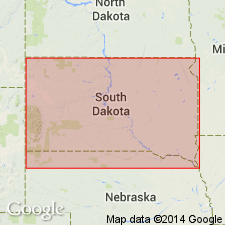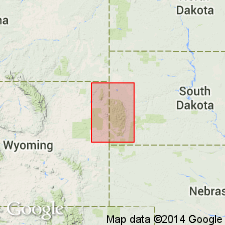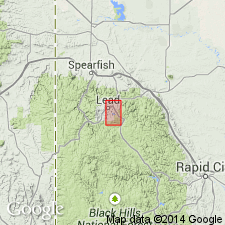
- Usage in publication:
-
- Homestake formation
- Modifications:
-
- Original reference
- Dominant lithology:
-
- Schist
- AAPG geologic province:
-
- Midcontinent region
Summary:
Pg. 793-799, 836-843, with maps. Homestake formation. Cummingtonite and chloritic schists, with contorted quartz stringers; in places dolomitic. Outcrops usually red and massive, the red color due to iron oxide. Greater part of formation is cummingtonite schist. Cummingtonite crystals vary in length from one-half to one inch; some are flattened along bedding planes. Original formation was a siliceous, ferruginous, dolomitic limestone, somewhat banded and in places well preserved; recrystallization probably took place with folding. Thickness 70 feet. Underlies Ellison formation. Overlies[?] De Smet formation. Age is Precambrian. Believed to be Keewatin age (Archean). Report includes geologic map.
Origin of name not stated, but probably named from Homestake Mine, Lead district, Lawrence Co., southwestern SD. Exposed west of Ellison shaft.
Source: US geologic names lexicon (USGS Bull. 896, p. 974); supplemental information from GNU records (USGS DDS-6; Denver GNULEX).

- Usage in publication:
-
- Homestake Formation*
- Modifications:
-
- Age modified
- Overview
- AAPG geologic province:
-
- Midcontinent region
Summary:
Age shown with other iron-formations (Xif, Pl. 1) Early Proterozoic in the Lead area, Lawrence Co, SD in the Midcontinent region. Iron-formation at base of Buck Mountain Quartzite of the Nemo area may be correlative of the Homestake. Is younger than the Poorman Formation. Geologic map.
Source: GNU records (USGS DDS-6; Denver GNULEX).

- Usage in publication:
-
- Homestake Formation*
- Modifications:
-
- Overview
- Dominant lithology:
-
- Schist
- Phyllite
- Iron-formation
- AAPG geologic province:
-
- Midcontinent region
Summary:
Is a carbonate and/or silicate dominated sequence. Locally massive to thinly bedded. Marked by abrupt stratigraphic changes. Thin chert beds are interlayered with the sequence. Separable into a siderite-dominant phyllite, miscellaneous iron-formation types, grunerite-dominant schist, and chloritic biotite-sericite-quartz-carbonate phyllite. The last rock type is transitional with the underlying Poorman and overlying Ellison Formation. Interpreted to have been a chemical sediment precipitated in a low-energy restricted basin. Authors believe hot spring activity influenced precipitation of iron. Stratigraphic diagram. Cross section. Geologic map. Mapped in the western part of the mapped area on the east part of the Lead dome, Homestake Mine area, Lawrence Co, SD in the Midcontinent region. Of Early Proterozoic age.
Source: GNU records (USGS DDS-6; Denver GNULEX).
For more information, please contact Nancy Stamm, Geologic Names Committee Secretary.
Asterisk (*) indicates published by U.S. Geological Survey authors.
"No current usage" (†) implies that a name has been abandoned or has fallen into disuse. Former usage and, if known, replacement name given in parentheses ( ).
Slash (/) indicates name conflicts with nomenclatural guidelines (CSN, 1933; ACSN, 1961, 1970; NACSN, 1983, 2005, 2021). May be explained within brackets ([ ]).

